
60
HNUE JOURNAL OF SCIENCE
Educational Sciences 2024, Volume 69, Issue 5B, pp. 60-71
This paper is available online at http://hnuejs.edu.vn/es
DOI: 10.18173/2354-1075.2024-0135
USING GEOGEBRA IN TEACHING CONES TO DEVELOP THE COMPETENCY
USING MATHEMATICAL AIDS AND TOOLS FOR GRADE 9 STUDENTS
Nguyen Le Hoai Thong1 and Hoa Anh Tuong2,*
1Phu Chanh Secondary School, Binh Duong Province, Vietnam
2Mathematics and applied, Sai Gon University, Ho Chi Minh City, Vietnam
*Corresponding author: Hoa Anh Tuong, e-mail: hatuong@sgu.edu.vn
Received May 12, 2024. Revised September 20, 2024. Accepted December 27, 2024.
Abstract. This article, based on theoretical and practical research on applying GeoGebra
software in teaching cones, aims to highlight the current situation related to teaching cones.
This is based on a survey involving 34 mathematics teachers and 63 ninth-grade students.
Additionally, the article illustrates the development of a lesson plan for ninth-grade cones,
emphasizing the direction of enhancing the students' competency in using tools and
mathematical learning resources through integrating GeoGebra software. Building dynamic
models using GeoGebra software helps students describe the concept of a cone and the
relationship between GeoGebra and real-life situations in ninth grade while enhancing visual
and dynamic aspects compared to traditional teaching methods. Furthermore, the article
introduces a tool for teachers, which only needs a GeoGebra file with pre-set tools. This tool
can be applied for teaching in any location if a computer with GeoGebra software is installed.
Keywords: software GeoGebra, the relationship between GeoGebra and real-life situations,
competency in using mathematical aids and tools.
1. Introduction
In recent years, the application of mathematical learning tools, especially mathematical
software, in education has experienced considerable growth. Among these software tools are
Cabri 2D and Cabri 3D, GeoGebra, Geometer’s Sketchpad, Maple, Matlab, and others.
Proficiency in using GeoGebra is considered an essential skill for developing competency in
utilizing mathematical aids and tools.
Key features of GeoGebra include as following: Drawing mathematical graphs for algebra,
geometry, and tables; Supporting drawing tools for mathematical shapes; Fast and accurate
computations; User-friendly interface for ease of use in the learning process.
GeoGebra has become a significant educational tool in the secondary school curriculum,
particularly since its introduction at the grade 6 level in Vietnam, starting with the Canh Dieu
series textbooks in the 2021 – 2022 school year. Some research on applying GeoGebra to teaching
mathematics, particularly functions, helps students enhance their ability to use mathematical tools
actively and positively engage in learning activities Asmin, Sembiring BN & Surya E [1], Bui
MD [2], Le VMT [3], Hohenwarter M, Hohenwarter J, Kreis Y & Lavicza Z [4], Nguyen HN [5],

Using GeoGebra in teaching cones to develop the competency of using mathematical aids and tools…
61
Nguyen TH [6], Singh LK [7], Vu LH [8], Wah LK [9], Wassie YA & Zergaw GA [10],
Yorganci S [11].
The ninth-grade Geometry curriculum is designed to explore geometric concepts closely
related to daily life, such as cones, cylinders, and spheres. According to the 2006 Math program
in Vietnam, the topic of Visual Geometry, especially the lesson on cones, mainly introduces and
solves concepts and formulas related to the lateral area, total surface area, and volume of a cone.
However, in the 2018 Mathematics Curriculum in Vietnam (issued with Circular No. 32/2018/TT-
BGDĐT on December 26, 2018, by the Minister of Education and Training), the requirements for
cone content are more specific and detailed. These include: Describing and constructing a cone,
including the vertex, generatrix, height, and base radius; Calculating the lateral area of the cone;
Calculating the volume of the cone; and Solving practical problems related to calculating the
lateral area and volume of cones.
For example, we have calculated the volume or lateral area of familiar cone-shaped objects. [12].
Therefore, the 2018 Math program in Vietnam provides more specific instructions for students to
develop their ability to learn and apply concepts related to cones in real-life situations DT Do [13].
In this article, we focus on constructing models to clearly illustrate the concept of a cone and
its surface area using mathematical tools, supported by GeoGebra software instead of presenting
“the rotation of a right-angled triangle around a fixed right-angle edge to form a cone”. This
approach aims to make the students' learning experience more dynamic and engaging, allowing
them to grasp the knowledge visually. According to this article, teachers and students require only
a laptop or desktop computer, along with the GeoGebra model file, to teach and learn about cones
at any time and from any location. Furthermore, through these models, students can improve their
ability to engage in self-directed learning and enhance their proficiency in utilizing mathematical tools.
Some studies related to the application of GeoGebra software in teaching visual geometry at
the secondary school level such as the Master's thesis: “Application of GeoGebra software in
teaching geometry proof at grade 7 secondary school” by author Cao Hai Dang at VietNam
National University, Hanoi has provided steps to build and guide students to apply GeoGebra
software to prove geometry problems in grade 7 HD Cao [14].
According to Irene Mukiri Mwingirwa and Miheso-O’Connor, teachers’ feedback showed
that GeoGebra was considered useful for teaching and learning Mathematics and would help
learners grasp concepts in Geometry, as cited in the article “Status of Teachers’ Technology
Uptake and Use of GeoGebra in Teaching Secondary School Mathematics in Kenya” Mwingirwa
IM & O’Connor M [15].
2. Content
2.1. GeoGebra
GeoGebra is a powerful and versatile mathematical software designed to support teaching
and learning mathematics. It uniquely combines geometry and algebra, allowing users to create
dynamic and visually interactive models with mathematical objects. A range of tools and
functions such as graphs, algebra, geometry, calculus, and statistics are integral parts of the
GeoGebra software. User capabilities encompass solving equations, computing derivatives and
integrals, graphing, conducting statistical data analysis, and performing a variety of other tasks.
The ability to create dynamic models, enabling users to move, modify, and interact with
mathematical objects in real time, is a standout feature of GeoGebra. This enhances the clarity
and engagement of the mathematics learning process. GeoGebra is extensively used in research
and mathematical applications across various fields, in addition to its role in supporting

Nguyen LHT & Hoa AT*
62
mathematics education from elementary to university levels. The software boasts a simple and
user-friendly interface, is easy to use, and supports multiple platforms, including mobile phones,
tablets, and personal computers.
We appreciate GeoGebra because it provides all the necessary tools for users to draw various
types of objects such as lines, circles, and three-dimensional geometry, meeting the needs of
mathematics teachers when designing instructional models.
2.1.1. Components for the competency of using mathematical aids and tools
According to the Ministry of Education and Training (2018), the components of competency
in using tools and resources for teaching mathematics in the general education mathematics
curriculum of 2018 are as follows:
- Recognizing the names, functions, usage guidelines, and storage methods of common visual
aids, as well as technological tools and resources (particularly those utilizing information
technology) that are essential for mathematics learning.
- Proficiently using mathematical tools and resources, especially technology-based tools, to
explore, discover, and solve mathematical problems, tailored to the cognitive characteristics of
the respective age group.
- Recognizing the advantages and limitations of various tools and supporting resources to
employ them judiciously.
We present the components of the competency of using mathematical aids and tools with the
support of GeoGebra as follows:
- Demonstration 1: Recognize the names, effects, and how to use Mathematical Aids and
Tools with the support of GeoGebra.
- Demonstration 2: Can use mathematical aids and tools with the support of GeoGebra to
explore, discover, and solve math problems (suitable for age cognitive characteristics).
- Demonstration 3: Recognize the advantages and limitations of Mathematical Aids and
Tools with the support of GeoGebra.
2.1.2. Some current situations related to teaching visual geometry
We conducted a survey using questionnaires distributed to 34 mathematics teachers at
secondary schools and 63 ninth-grade students via Facebook from February 16, 2023, to February
22, 2023. The purpose is to get opinions from teachers and students about using GeoGebra and
the difficulties encountered when learning cone content in 9th-grade visual geometry. Based on
this, we designed tools using GeoGebra to support the teaching and learning of cone-related
content for ninth-grade students.
The following are survey questions related to teachers, ranging from question 1 to question 5.
the purpose is to gain insight into teachers' opinions, perceptions, and evaluations concerning the
importance of using mathematical aids and tools, supported by GeoGebra software, in teaching
cone geometry within the visual geometry curriculum for ninth-grade students. We conduct
survey question 1 to gather insights. Question 2 was designed to understand how teachers use
GeoGebra to teach cone geometry in grade 9. Survey question 3 aimed to identify the challenges
teachers encounter when teaching cone geometry within the visual geometry curriculum for ninth
grade. Survey question 4 was used to assess teachers' opinions on the extent to which tools and
resources supported by GeoGebra are utilized in teaching the surface area of cones in the visual
geometry curriculum for ninth grade. To gather teachers' opinions on the extent to which tools
and teaching resources, supported by GeoGebra, are used in teaching volume problems related to
cone geometry within the visual geometry curriculum for ninth grade, we conducted survey
question 5.

Using GeoGebra in teaching cones to develop the competency of using mathematical aids and tools…
63
Question 1. In your opinion, is it important to develop the Competency of Using
Mathematical Aids and Tools through teaching cones for grade 9 with the support of GeoGebra?
Figure 1. Teachers' opinions, perceptions, and evaluations regarding the importance
of developing competency in using mathematical aids and tools
through teaching cone geometry in the visual geometry content for ninth grade
with the support of GeoGebra software (34 answers)
Question 2. What activities do teachers often organize to develop the Competency of Using
Mathematical Aids and Tools through teaching cones for grade 9 with the support of GeoGebra?
Figure 2. Teachers' opinions on activities aimed at developing competency in using
mathematical aids and tools through teaching cone geometry in the visual geometry content
for ninth grade with the support of GeoGebra software (34 answers)
Question 3. When teaching grade 9 students about cones, what challenges do teachers often
encounter?
Figure 3. Teachers' opinions on the challenges faced when teaching the lesson on cone
geometry within the visual geometry content for ninth-grade students (34 answers)
Question 4. In your opinion, how often do you use Mathematical Aids and Tools in the
problem of calculating the surface area of a cone with the support of GeoGebra?

Nguyen LHT & Hoa AT*
64
Question 5. How often do you use Mathematical Aids and Tools in calculating the volume
of a cone for grade 9 with the support of GeoGebra?
Figure 4. Teachers' opinions on teaching to develop competency in using mathematical aids
and tools in problems related to calculating the surface area of cones within the visual
geometry content for ninth grade, with the support of GeoGebra software (34 answers)
Figure 5. Teachers' opinions on teaching to develop competency in using mathematical
aids and tools in volume problems related to cone geometry within the visual geometry
content for ninth grade, with the support of GeoGebra software (34 answers)
From questions 6 to 10, we surveyed students' opinions and experiences related to their
learning of cone geometry. Survey question 6 was designed to understand students' perceptions
of the difficulty level of learning about cones. Question 7 aimed to examine the challenges that
students encounter during their study of cone geometry. Survey question 8 inquired about
students' views on the importance of developing their ability to apply, explore, and discover
mathematical tools and learning resources. Question 9 assessed the frequency with which students
develop these skills in solving surface area problems related to cones within the visual geometry
curriculum for ninth grade, supported by GeoGebra software. Finally, survey question 10
evaluated how often students develop the ability to apply, explore, and discover mathematical
tools and resources in solving volume problems in a visual geometry class for ninth grade, with
the support of GeoGebra software.
Question 6. What do you think about the cone lesson?
Figure 6. Students' perceptions of the difficulty level in learning about cones
within the visual geometry topic for the ninth grade (60 answers)


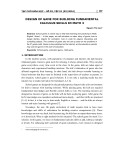

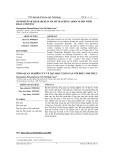

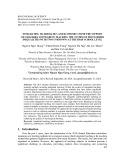
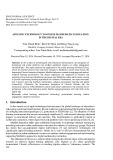

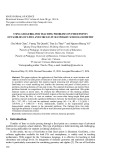
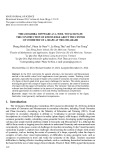

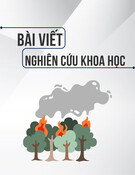
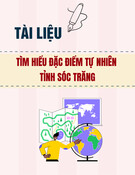
![Quy hoạch tổng thể Cà Mau: Tài liệu [mới nhất/chuẩn nhất]](https://cdn.tailieu.vn/images/document/thumbnail/2025/20250827/tghong1621@gmail.com/135x160/49401756278390.jpg)

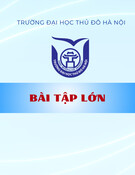
![Bài giảng Hàng hải địa văn [chuẩn nhất]](https://cdn.tailieu.vn/images/document/thumbnail/2025/20250729/vijiraiya/135x160/43361753782101.jpg)
![Bài giảng Trắc địa cơ sở [mới nhất]](https://cdn.tailieu.vn/images/document/thumbnail/2025/20250729/vijiraiya/135x160/84_bai-giang-trac-dia-co-so.jpg)





![Atlas tài nguyên nước Việt Nam: Tài liệu [Mô tả/Hướng dẫn/Chi tiết]](https://cdn.tailieu.vn/images/document/thumbnail/2025/20250715/vijiraiya/135x160/348_tai-lieu-atlas-tai-nguyen-nuoc-viet-nam.jpg)
![Hệ thống câu hỏi ôn tập Vùng kinh tế [chuẩn nhất]](https://cdn.tailieu.vn/images/document/thumbnail/2025/20250709/kimphuong1001/135x160/76921752140578.jpg)
